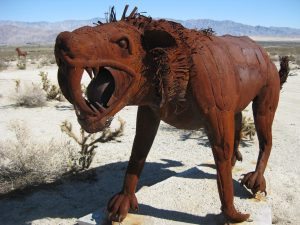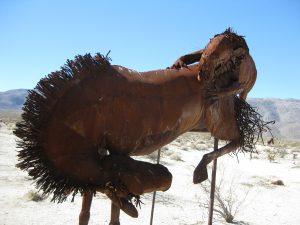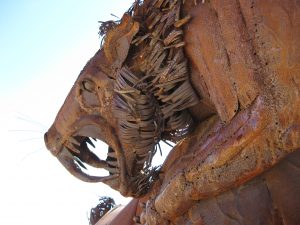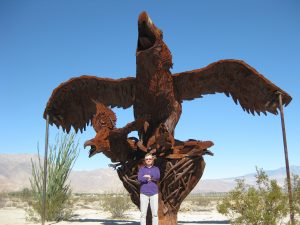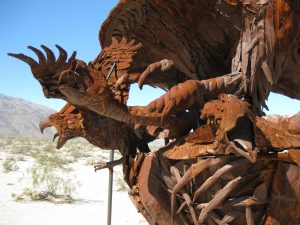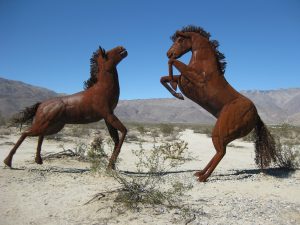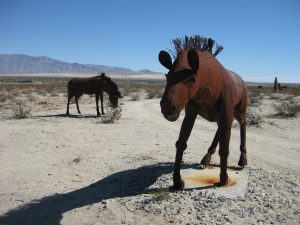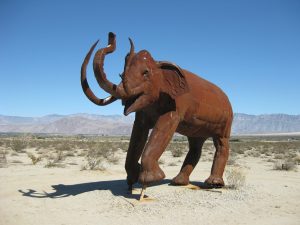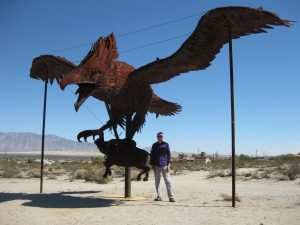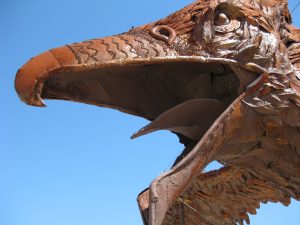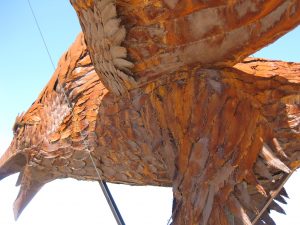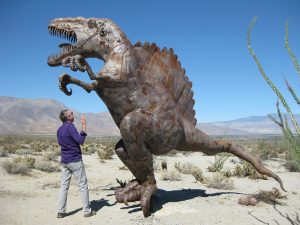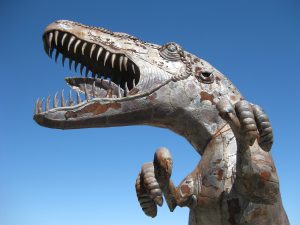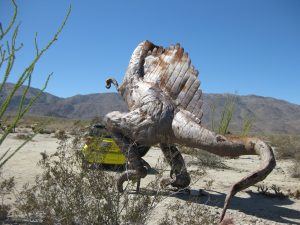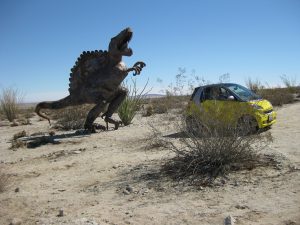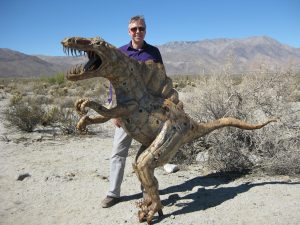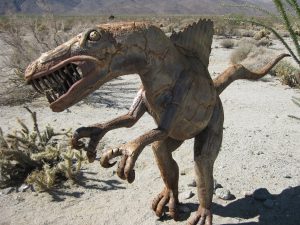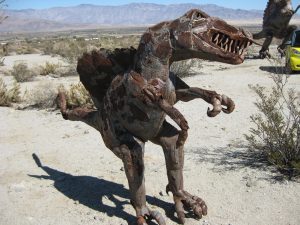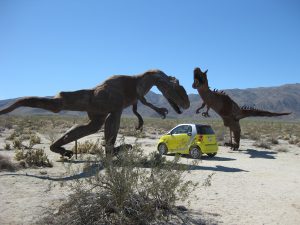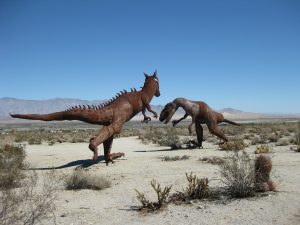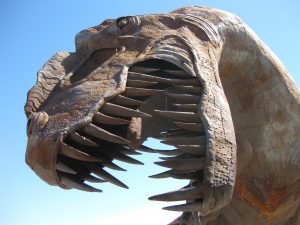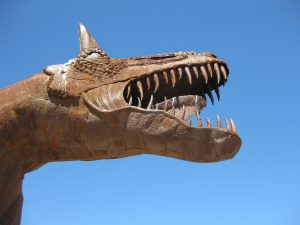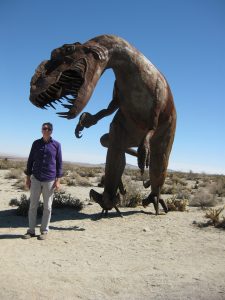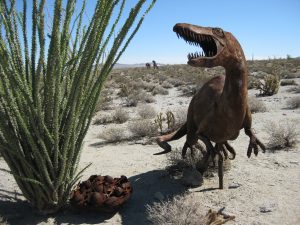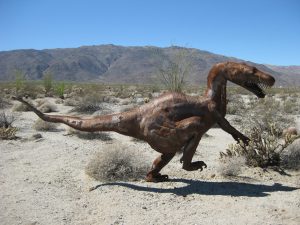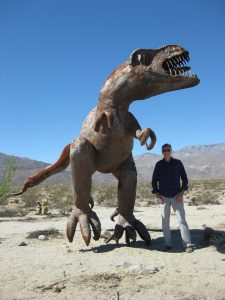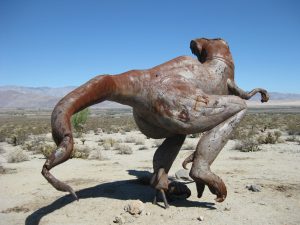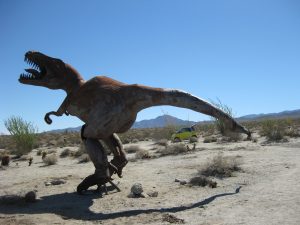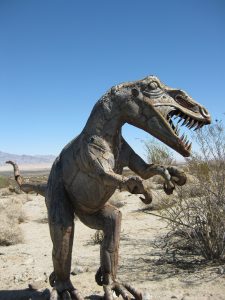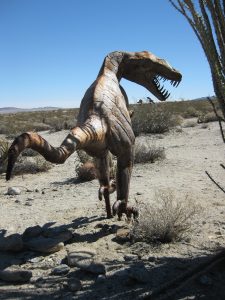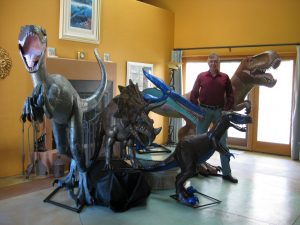It’s time to head south on Borrego Springs Road from Palm Canyon Drive. The road will curve east after approximately 3 ¼ miles and on your right you will come across several Sabretooth Cats and Horses. You’ll have to decide if you wish to drive off road a bit or view them all on foot. Unlike the Sabretooth Cats in the north end of the valley these all have manes. Their poses give you the feel of movement – these cats are stalking, chasing and attacking the horses. I know sad, but it was the way of things.
On the opposite side of the road just a little further east, (however a long walk from the road) is an Incredible Wind God Bird (Aiolornis incredibilus) in nest. Fossil specimens date from 3.5 to 0.5 million years ago. Their presence indicate streams, lakes and ponds were once located in this desert. First the size of this sculpture is magnificent and the details to each metal feather attached will overwhelm you. Continuing east on the same side of the road several more extinct horses followed by the Columbian Mammoth. Horses originated in North America 57 million years ago. There were several emigrations to the Old World. Horses became extinct in North America 11,000 years ago. Mammoths are medium to large elephants, which originated in Southern & Eastern Africa approximately 4 million years ago. They spread throughout Europe, Asia and North America. Fossils of two species are found in Anza-Borrego. The largest the Columbian Mammoth dates 1.1 million years ago.
Continue east and make a right turn onto Anzio Drive. Another Incredible Wind God Bird can be easily seen on the right hand side of the street an easy walk or short drive off road. This Aiolornis Incredibilus is in flight and carrying prey – an extinct peccary. This was the largest flight-capable bird in North America with a wingspan of 17 feet. It was approximately 4 feet tall. This sculpture is significantly larger – about twice the size of the actual fossil remains. Only 6 specimens of this bird have been found and 3 of them come from Anza-Borrego.
Our next four stops will take us to some very impressive Dinosaur sculptures. Ricardo Breceda’s dinosaurs are posed to make them appear in motion. This certainly makes them more life-like and scary!
Continue south to the end of Anzio Drive and resume on a dirt road. To reach these last four sites on foot would be a very long hike. Be extremely cautious driving off road in this area. On my trip it appeared that some flash flooding had occurred making the roads here very uneven with a great deal of exposed rocks. So again be careful drive slow. The road turns to the right (west). Fortunately, the Spinosaurus at the first stop in this area is around 12 feet tall, making it visible from quite a distance. There are various trails from people driving around in this area. You should be able to see the Spinosaurus straight ahead if you have made the correct right turn. There are 3 young Spinosaurus at this site too! Spinosaurus adults were 41 to 59 feet long. The spins on their backs have been measured at 5.4 feet in length.
Continue west and you can’t miss the Allosaurus and Carnotaurus preparing for battle. Maybe I should have parked somewhere else.
I want these guys in my yard! Allosaurus could reach 43 feet long and Carnotaurus up to 30 feet. Again Ricardo Breceda’s attention to detail is awesome! You can see how important it is to have someone in the picture to realize the scale of these sculptures. They can be seen all the way from Borrego Springs Road where you were visiting the Sabretooth Cats & Horses. Continue west to the Utahraptors. You’ll notice you can see the Allosaurus and Carnotaurus in the background of the Utahraptor guarding its eggs. Utahraptors could reach 23 feet in length. They are the largest known Raptors in the Dinosaur family.
Just a little further west and to your right – Tyrannosaurus Rex. An adult could reach 40 feet in length and 12 feet high at the hips. There are 3 young T-Rexes at this site to entertain you, as well. You can still see the Allosaurus and Carnotaurus in the background of one of the baby T-Rexes.
You’ll notice in the various pictures the Spinosaurus and T-Rexes appear to have a coating that is pealing. Per my conversation with Ricardo Breceda, they were coated with a lacquer. This shows you the need to maintain the finish you select for your metal dinosaurs. Different sculptures have held up better than others over the years many without any special protection.
Many of the sculptures still have tags with numbers. I’m assuming indicate the order of production. For example, one Velociraptor on Galleta Parkway is #62, the Mule on Stagecoach Way #79, a Sabretooth Cat in the south valley off Borrego Springs Road #21 and one of the Utahraptors on the dirt road southeast of Anzio Drive #11. The numbers are lower in the south part of the Borrego Springs Valley, perhaps they have been exposed to the weather longer. Ricardo created and placed these sculptures starting in 2008 and the final one in 2010. Flash flooding in the area could be a contributing factor, as well.
Remember to take in to consideration your weather conditions when adopting and selecting a place for your metal dinosaur(s).
For more information on the Anza-Borrego Desert, here are a few publications you can check out:
Fossil Treasures of the Anza-Borrego Desert – The Last Seven Million Years edited by George T. Jefferson and Lowell Lindsay (2006)
- Inspired the first sculptures
Geology and Lore of the Northern Anza-Borrego Desert Region (2010)
Ricardo Breceda: Accidental Artist (2012) by Diana Lindsay
For the most current information visit the Anza-Borrego Desert State Park Visitor Center on Palm Canyon Drive.
It was a long drive for me to make in 1 day over 400 miles round trip. But I think it was well worth the time! I’m still enjoying the 264 pictures I took on the trip. I hope you will find the time to see these great works of art in person and capture special memories for yourselves!
Paul & Prehistoric Pals
Your feedback is appreciated, Thank you!
